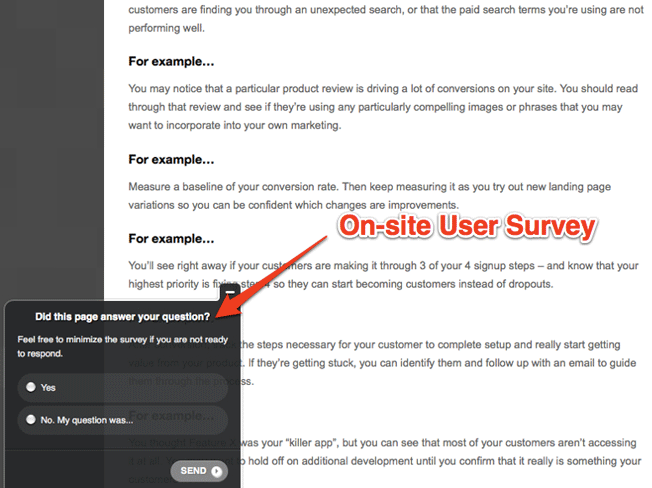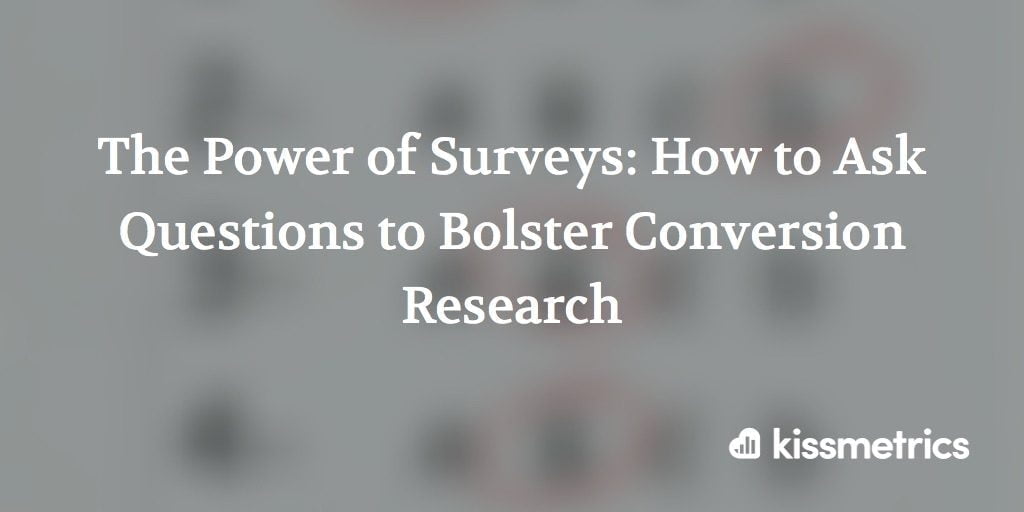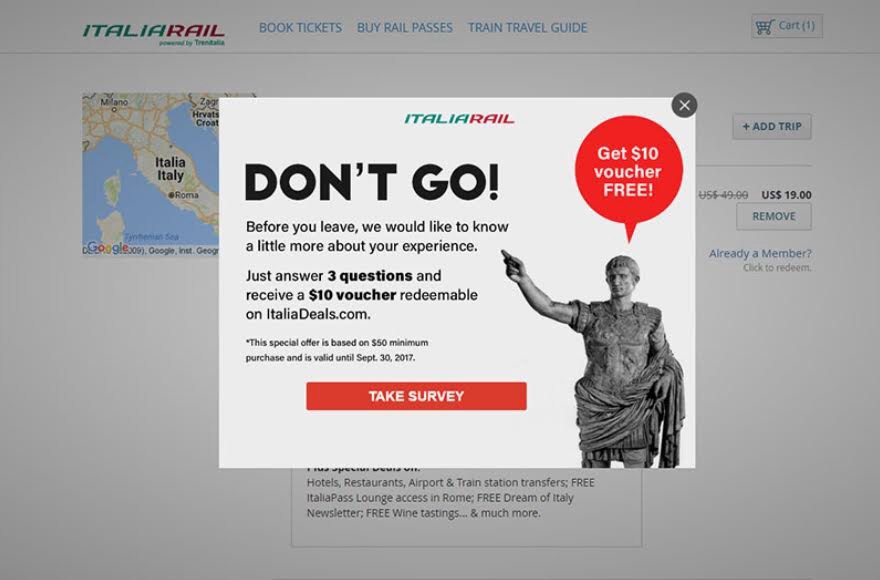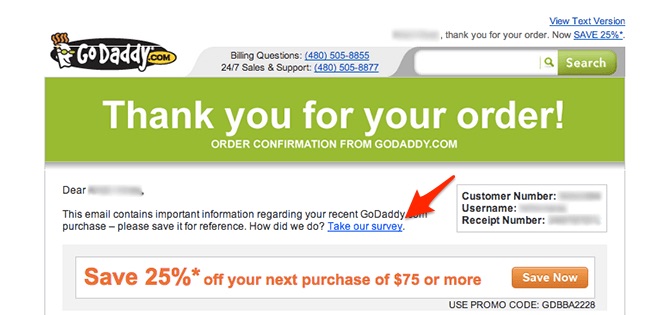Surveys are becoming increasingly powerful tools in the hands of professional digital and content marketers. Utilizing the power of surveys, you can collect crucial data to research your targeted audience, identify usability issues and much more. Among other things, you can use survey data to research and boost conversions.
And yet, be careful. Surveys can be very dangerous. If done incorrectly, they will supply you with confusing and possibly misleading data that can potentially decimate your entire digital marketing campaign.
When done correctly, survey data can offer countless potential benefits but, nevertheless, approach it with extra care. To mine useful data from your surveys, create surveys that are short, clear and to the point. Users often have short attention spans, and reliance on mobile devices has made concise messaging imperative.
And how do you create surveys that attract customers, keep them glued to their screens and encourage them to share eye-opening insights with you?
With better questions!
In this article, I will introduce you to the amazing world of surveys and conversions. I will explain why you should run surveys in the first place, showcase different types of surveys, and examine major mistakes marketers make when creating surveys. Let’s dive in!
Use of Surveys for Conversion Research & Optimization
The first question we need to answer is, why do we actually need surveys?
To say we need surveys for data collection and research is a pretty straightforward but hasty answer. If we dig deeper, we can also uncover answers like:
- Research existing user personas
- Find and clarify new customer personas
- Identify friction points and stumbling blocks
- Notify about products, services and content
- Get product or service feedback
- Collect and research new marketing ideas
While all of these reasons are legit, why should we rely on surveys to extract that information?
There exist a wide variety of tools for collecting and researching marketing data: Google Analytics, SimilarWeb, Ahrefs, SEMrush, Buzzsumo, Kissmetrics, Klout — to name a few. And if we have so many effective instruments that never lie about collected data, why rely on people whose answers can easily be biased or misleading?
Here’s why:
No matter how inaccurate surveys can be, they answer important business questions. The quality of these answers depends entirely on your ability to ask your audience better questions — questions that are not only clear and specific but emotional and motivational.
What kind of business questions are these?
- Why?
- Who?
- What?
- How?
- Where?
- When?
There are multiple ways in which you can ask these questions, and this is exactly what makes surveys so exciting and complex. For instance, you can try asking your customers:
- Why did you choose our service?
- What made you choose our service?
- What convinced you to choose our service?
These survey questions differ in form but basically seek the answer to one single question — Why us? And here is the deal: the form, structure and wording of your questions matter a lot.
Whatever you do, most of your survey replies will vary. Yet, you should formulate questions to encourage your targeted audience to provide detailed and easily interpreted answers. You have to compose survey questions with a clear picture of who is going to answer them.
Surveys can help identify conversion friction. Using smart surveys, you can figure out why users leave, don’t convert, don’t buy anything or simply churn. And bear in mind that surveys can be a main source of friction on their own.
Surveys add a human touch to your business, too. They show that you care about your customers and you do your best to solve their problems and soothe their pains. Surveys are great for building perfect rapport with your audience. However, be careful.
The Danger of Low-quality, Intrusive Surveys
Very few surveys deliver actual value to customers, and customers recognize a contrived survey pretty quickly. Nobody wants to take part in your marketing game for free.
Low-quality surveys can damage your reputation. If you abuse the practice by bombarding users with too long, too many or too confusing surveys, your brand’s reputation will suffer. Push emotional buttons but don’t go overboard. Being too intimate can be harmful too.
Intrusive surveys are a definite no-no, too. If your surveys are a nuisance to your customers, your exit and bounce rates will go up, which decreases your site’s ranking potential. Obviously, you do not want that.
With that said, it is clear why so many companies avoid running surveys. They are afraid of alienating their targeted audience and getting on Google’s radar. But the benefits are worth the risk.
Surveys can become your unlimited source of insights that, if utilized correctly, can help you remove friction points and stumbling blocks, reduce anxiety, and bolster conversions. All you need is to learn to ask better questions.
Types of Surveys: Efficient Questions
There is no magic formula for good survey questions. However, there are basic guidelines you can follow to craft, test, apply and process your survey questions.
We need to start with fundamentals and learn about the different types of surveys and survey questions. But even before that, I would like to point out two important rules:
- The type of survey you choose and the structure of your survey questions depend a lot on your research goals.
- Efficient surveys cannot be run outside the context of your industry, your company and your customers.
Always keep these two rules in mind throughout the survey building process.
Speaking of types of surveys, you can break them down:
- By platform
- By question type
- By customer type
- By goal
Let’s have a closer look at these survey types and provide some examples of efficient questions you can ask to take your conversion research process to another level.
Surveys by Question Type
Here I point out four types of surveys:
- With closed-ended questions
- With open-ended questions
- With mixed questions
- With follow-up questions
Surveys with Closed-ended Questions
Surveys that feature only closed-ended questions are not very effective. While there is no denying their answer rates are high, in most cases they do not provide much useful information. Just have a look at this example:

Here you have two answers: “Yes” and “No. My question was…”. This is not entirely bad; when you press “No. My question was…”, you will be able to type in your question and provide insightful data to those who run the survey.
But let’s consider that you launch a survey only with “yes” and “no” options. Will it be helpful? Truth be told, it can be, but the data you collect won’t be very specific.
Surveys with Open-ended Questions
Surveys with open-ended questions don’t follow the simplistic “yes-or-no” model but encourage full, meaningful answers. And they can be a challenge because people will not always want to stop and think about what you need or how to answer your survey.
Surveys that feature open-ended questions are valuable to you, but users often hate them.
So what can you do to incentivize users to take full, long surveys?
The answer is:
Harness the power of surveys that feature both closed-ended and open-ended questions.
Here is your ideal survey strategy:
- Come up with a simple, closed-ended question (this is your hook)
- Place this silver-bullet question at the beginning of your survey
- Continue the survey with one or two open-ended questions
- Add a follow-up question for users who churn or drop out of the survey
For example:
- Did our product make life better for you? [Yes/No]
- What problem did our product solve for you?
- Did you have any hesitations before purchasing? Why?
- Our product changed your life for the better. Tell us how [follow-up]
Surveys with Follow-up Questions
Last but not least are follow-up questions. I recommend using these when your survey features several open-ended questions. You should track where users drop out and encourage them to continue the survey, offering incentives like promo codes, coupons, gift cards, discounts and so on.
Surveys by Customer Type
You should never run surveys out of context, and knowing who you are going to survey is an integral part of the equation. Here are customer types you want to survey:
- Current customers
- Engaged customers
- Churned customers
- Prospective customers
Current Customer Surveys
Current customer surveys are your bread and butter. If you fail to extract knowledge from these, it will be much harder for you to locate pain points of your audience and attract new customers.
So, what types of questions should you ask when running surveys of your existing customer base?
David Darmanin, CEO at Hotjar, recommends asking questions like:
- Where did you hear about our company/product/service?
- How would you describe our company/product/service to your relatives and friends?
- What would your obstacles be if you suddenly stopped using our product/service?
- What is our company/product/service missing?
- What kinds of challenges do you overcome every day?
Keep in mind that you should not force answers out of your customers. Keep your surveys between three to five questions maximum.
Engaged Customer Surveys
Surveys of engaged customers are next on the list. To efficiently create and run these, keep in mind that engaged customers are:
- Those who are to help you and can potentially act as your brand advocates
- Your community that is satisfied with your company, products, services, and content
- Users who have converted into leads or have been closed as customers
You have to do your best to delight engaged customers. Run surveys to figure out how to improve their experience with your site, products and services.
If you manage to satisfy your loyal base of customers, you will achieve three goals:
- Increase conversions – Satisfied customers convert better
- Improve customer lifetime value – They will follow you and return for more
- Build a loyal base of brand advocates – People love to share their positive experiences with others. Encourage them to mention your brand in a favorable way
What questions can you ask to survey engaged customers?
- Are you proud to be our customer? [Yes/No]
- What can we do to improve your experience using our site?
- What is the likelihood of recommending our company/product/service to your family and friends?
These questions can have many variations but all of them should focus on why. Why did your customers choose you? Why do they keep returning to your website but don’t convert? And so on.
Churned Customer Surveys
Now that we are done with the ‘converted’ part of your customer spectrum, let’s figure out how you can survey your ex-customers — customers who churned.
Some digital marketers and CRO experts turn a blind eye to churning customers, which is a huge mistake. The thing is, churning customers cut ties with your company for a reason — always! — and your job is to survey them to figure out why. Learn the ‘why’ and you will reduce the churn rate.
To do that, you can rely on on-site surveys or outreach emails (provided you have collected them into your email base).
Here are a few questions you can ask both in your surveys and in outreach emails:
- Have we failed to deliver on what we promised? [Yes/No]
- What has encouraged you to leave our brand / unsubscribe / opt out of…?
- Are there any problems on our site you want to share with us?
Prospective Customer Surveys
Prospective customer surveys differ from all other types, as they are run primarily with outreach email campaigns. What makes them particularly complex is that the prospects are “cold” and don’t know anything about you or your brand, which automatically makes them less inclined to spend their time even opening your email.
Launching and running efficient outreach campaigns is never easy. I recommend checking out this wonderful guide by Tim Soulo to learn more about it.
Hey *|FNAME|*,
I stumbled upon your profile on [] and wondered if you’d be interested in taking part in a survey I am currently running about []. This is not a sales scheme — this survey does not obligate you to purchase anything.
The survey includes only five questions and should take 5-10 minutes of your time. Let me know if you are interested!
Thanks,
[Your Name]
If they are interested, send a follow-up email right away. Like this one:
Hey *|FNAME|*,
Thanks for agreeing to take part in the survey!
Click the link below to start:
[Link]
And once again — thanks for your time!
Cheers,
[Your Name]
As a result, you receive valuable insights and attract interest to your company, products and services.
Surveys by Goal & Customer Action
Here we have the following types of surveys:
- Early-exit surveys
- Thank-you surveys
- User-testing surveys
Early-exit Surveys
Early-exit surveys can provide you with tons of eye-opening insights about your site, your products and services — simply because unsatisfied users are more likely to direct you to pitfalls on your site.
As a rule, these surveys come in the form of popups. A customer visits your site, starts completing a targeted action, and then drops out — here is when your survey should pop up on their screens. Consider the example below:
Some survey question examples are:
- What is stopping you from…?
- What is your biggest challenge doing…?
- What is your biggest problem visiting…?
- You have dropped out. What can we do to improve your experience?
The important thing to remember here is, intrusive popups and interstitials create an obstacle to your search engine optimization efforts. Google will punish your site if you fail to follow these guidelines. You need to find the right balance between surveys and SEO. Otherwise, you risk causing high bounce and exit rates.
Thank you Surveys
Surveys of customers who have already converted are always a pleasant experience, but that does not mean you should run them hands down — from now on your responsibility is to delight your recently converted customers and, on occasion, remind them about you and your brand.
Thank you or post-conversion surveys are a must because converted customers feel positive about your brand and are more inclined to give replies to open-ended questions. Harness post-conversion magic to pinpoint areas you need to refine or fix.
Post-conversion surveys can be run on your thank-you pages or in post-conversion emails.
They should not be too long. You want to ask questions like:
- Why did you purchase our product / sign up for our service?
- How did we do?
- Did you like our service?
- Could you please share your thoughts and experiences about the purchasing process?
- Why did you choose Version A of our product over Version B?
The example thank you page below demonstrates how to encourage customers to take post-conversion surveys:
Post User-testing Surveys
User tests are the lifeblood of conversion rate optimization. The way a specific user or a group of users navigates your website, clicks buttons and fills out forms can tell you a lot about usability issues you need to fix.
However, just watching how users follow through with tests is not enough. You can extract many more insights if run a survey directly after the session. You might ask the following questions:
- What do you like about our website?
- What do you dislike about our website?
- Are there any problem areas we need to improve?
- Has anything specific stopped you from doing …?
- Do you have any comments?
Knowing where, when and how to run each type of the survey is vital to the success of your conversion research efforts. However, even if you are good at surveys and can formulate insightful questions like a pro, you still may not get the results you want, often because you are making one of the following mistakes.
Mistakes to Avoid When Crafting and Running Surveys
Quality surveys can become your crystal ball, your secret to efficient conversion research and high conversion rates. However, they can easily lead you down the wrong path. Metaphorically speaking, you will not see your site’s true issues through multiple ‘survey trees’ if you plant them incorrectly. Here are some common mistakes:
1. Creating and Running Surveys Without a Clear Objective
Making your customers answer survey questions because ‘it is our practice,’ or ‘my competitors do that’ is not a smart approach to conversion rate optimization. Every survey you launch on your site should have a clear goal behind it.
Just think about it like this:
If I did not do my homework, figuring out why and for what purpose I am running the survey, why would my customers take part in it? If I took shortcuts putting out the survey, why wouldn’t they do the same thing by dropping out of it?
Before you ask any questions of your customers, make sure you think of the following:
- What are my business objectives?
- What do I need the survey for?
- What kind of data do I need to collect in the survey?
- How much data do I need to collect?
- How am I going to process and analyze the collected data?
These are not trite questions. The right answers can save hours of time that you can use for other tasks.
The bottom line is, don’t bother your customers with surveys if you don’t know why or how to run them. When you do, you risk being ignored by your customers at times when you launch surveys that really matter.
2. Targeting the Wrong Users with Your Surveys
Knowing your target audience is a key condition of efficient marketing, and it is pretty much the same thing with surveys. If you don’t know who you are going to survey, even the most brilliant questions won’t make a difference.
Before creating a survey, you need to answer the question: Who am I going to survey?
Do you want to survey customers who put a product in the cart but did not buy? Recent buyers? First-time customers? Loyal brand followers?
Get your bearings before investing time in crafting and launching any survey. Prior research and analysis of your target customers are absolutely key to success.
3. Collecting the Wrong Number of User Responses
The wrong sample size can become a huge issue whether running qualitative or quantitative surveys. You can collect too many surveys and spend days analyzing the data, generating hypotheses and uncovering trends. You can also collect too few surveys and end up with a wide margin of error that makes the survey useless in the first place.
You have to find the right balance between the number of surveys and the acceptable margin of error. Basically, you should collect enough surveys to allow you to spot the trends without forming false patterns.
The question is, how can you do that?
- Use this Sample Size Calculator to get an idea of the margin of error for your sample size.
- Follow the advice of CRO professionals: As a rule, surveying between 100 and 200 customers is enough.
- Analyze all the data you can get. If you only collect 20-30 surveys, go with it. Some surveys are better than no surveys at all.
4. Targeting Users with the Wrong Questions
The gift of asking the right questions to the right people at the right time is a truly brilliant quality that only a few people have. Yet, with a little effort, you can master it. Here are some tips:
- Formulate survey questions using the specific language of your customers
- Use actionable, motivational verbs (e.g. create, hope, express, compete, challenge)
- Include audience-specific emotional triggers
- Place your most important questions at the beginning
- Run surveys in context (ensure that your customers don’t have any fears and doubts about taking part in the survey)
The bottom line is, the quality of your questions correlates with the quality of data you collect in your surveys. There is no other way around it.
5. Analyzing the Collected Data Incorrectly
Truth be told, there is no one single method to analyze survey data. Your approach to looking at data depends on too many things, like target audience, goals, sample size, etc.
But that does not mean you are free to analyze data any way you want. I recommend developing a standardized data analysis routine. For instance, you can do it like this:
- Recall your survey goal and write it down so that everybody can see it upfront
- Review the collected data. Look through the surveys to get a better feeling for your customer voice, noting major trends
- Come up with codes for different data categories. You can place data in separate columns or tag them. This helps distribute raw survey data
- Analyze the raw data
- List all the spotted trends and make conclusions
The rule of thumb is that you need to test your survey analysis routine. A universal recipe does not exist.
6. Drawing Conclusions on Your Own
Neither you nor other people who analyze survey data are perfect in their judgement. All of us suffer from multiple biases and stereotypes, and this is a huge problem when we need to interpret data and form hypotheses. Put simply, even if your survey data is all quality, you can easily error when analyzing it.
So, what can you do?
To reduce a high risk of drawing false conclusions from your surveys, you should never analyze it on your own. If you are the only CRO professional on board, at least ask your colleague to look at some of the results. I guarantee this will be a useful thing to do.
Final Thoughts
Surveys can become your main weapon for efficient conversion research. If you learn how to craft survey questions that stick and extract lots of useful data from your prospective and current customers, you will gain access to a constant stream of insights.
Be careful, though. You should survey the right people, at the right place and in the right time. One single error and you risk corrupting data quality in no time.
Make sure that you prioritize such factors as research goals, survey length and clarity, respondent experience, completion rate and company reputation, and you will be just fine. Consider using emotional triggers, motivational content and user-specific language.
Keep all of these in mind and I guarantee that you will get tons of insights quickly. Good luck, and never forget to test your results.
About the author: Sergey Grybniak is a serial entrepreneur and a digital marketing expert. He has been providing digital marketing services for over 10 years and have successfully completed more than 500 projects. Having experience in launching and promoting e-commerce platforms, Sergey helps small- and midsized businesses establish a thriving web presence; owns a digital marketing agency Clever-Solution.com. He is also founder of online b2b/b2c marketplace Opporty.com.


